There are many low-growing perennials that can maintain their decorative properties from early spring to late autumn. We will talk about such ground covers today.
Among them you can choose plants that bloom beautifully and abundantly, species with decorative foliage, and chiseled shapes. A matter of taste, desire and design idea.
In addition to decorative, ground covers have a purely practical role:
- As they grow, they protect the soil from drying out, overheating, frost, and erosion.
- Their roots help maintain the structure of the soil.
- Stems and leaves, dying, replenish the soil with organic matter.
- Weeds cannot break through their thick cover
Giving advice on where and how to plant these plants is a thankless task, especially without having in front of your eyes a site on which groundcover perennials will grow. Therefore, I will simply describe several ground covers widely used in gardening. All of them are beautifully flowering, very unpretentious, easy to plant and care for.
Ground cover flowering perennials
Phlox subulate
The first plant that comes to mind when it comes to beautiful ground covers. Probably because its neat curtains with small needle-shaped leaves are already densely covered with pink, blue, and white flowers in the spring.
If you want a monochromatic spot in a flower garden, plant one variety; if you like calico variegation, place plants with flowers of different colors nearby.
Phlox subulate is an excellent frame for a garden path, flower bed, harmonious in rock gardens and mixborders. It will not spoil the overall picture of the garden even after flowering: the phlox clumps remain neat until the end of the season.
It grows well and reproduces well by cuttings. Having bought one or two plants, in a year you will be able to have as many as you need to decorate the site.
Another phlox - spread out - can also play a ground cover role. Its flowers are larger, but more rare. It blooms somewhat later than the Phlox subulate, as if taking the baton from it.Grows well in sunny areas.
Brief agricultural technology:
- Sowing seeds in the ground: in spring - in April, in autumn - in September.
- The soil is poor. Flowering is less abundant on nutrient soils. A fast-growing groundcover perennial.
- Location: sunny areas without stagnant water.
- Watering is moderate.
- It prefers wood ash as a fertilizer. With excess min. fertilizers develops green mass and blooms poorly.
- For the winter, a shelter made of spruce branches is desirable. In lowlands, where water accumulates during the thaw, plants can dry out.
Video about the use of awl-shaped phlox in garden design.
Yaskolka
A ground cover perennial with creeping shoots forming beautiful silvery curtains 10-15 cm high, on which many small white flowers bloom in May. Yaskolka is unpretentious and winter-hardy.
It grows quickly and covers a large area with a carpet in a short period of time.
It is not difficult to obtain a seedling from seeds, sowing them in the spring for seedlings or before winter. The seedlings will bloom in a year.
Brief agricultural technology:
- Prefers well-lit places.
- The soils are light.
- Moderate watering
- Feeding is not required. An extremely unpretentious ground cover.
- By pruning the shoots after flowering, you can achieve repeated flowering.
- Propagated by dividing bushes and cuttings in late spring.
- For the winter, the above-ground part is cut off and covered with spruce branches.
Look what a tree plant looks like in the garden:
Clove - herbal
There is no need to even characterize this herbaceous perennial in detail: its features are reflected in the name. The carnation means it blooms beautifully. Grass - because its curtain looks like a mound of short grass.
At the end of spring, the creeping shoots of the grass are decorated with single, medium-sized red flowers visible from afar.
Brief agricultural technology:
- Sowing seeds for seedlings in March under glass, then flowering begins in June. In open ground in May - flowering at the end of July.
- The grass loves the sun.
- Moderately moist fertile soil.
- Planted in areas that are not flooded in winter. In low places it may disappear.
- Propagated by dividing rhizomes in spring and autumn, and by seeds.
- This perennial can withstand frosts down to - 35º
What does a carnation look like in a flowerbed:
Duchesnay
Another very pretty ground cover perennial with creeping shoots that easily take root in the nodes. The dark green trifoliate leaves are very similar to strawberry leaves, as are the bright red small fruits. True, they are inedible, but they are always in sight.
Duchesnea grows well in lighted places and is not picky about soil. It spreads very quickly and can even be aggressive.
Agricultural technology:
- It is better to plant on poor soils; in fertile soil the flowering will be weak and there will be a lot of leaves.
- The soil must be kept moist, otherwise the “mat” will not be continuous and sparse.
- It propagates vegetatively (by dividing the bush, rooted rosettes) and by seeds, which can be sown in both spring and autumn. Fast growing ground cover.
- Winters well under snow. May freeze in snowless winters
Duchesnea lawn:
Stachys woolly
Herbaceous rhizomatous perennial with creeping rooting shoots. Its silver-gray pubescent leaves look great in borders, mixborders, and rockeries.
Spike-shaped inflorescences, consisting of pink or mauve flowers, are most often cut out before flowering, so that they do not disturb the outline of an even fluffy rug “spread” along the path or framing the flower garden. Old rhizomes are also systematically cut out.
Stachys grows well in open areas with light soil and moderate watering.
Brief agricultural technology:
- Sowing seeds in May or autumn in September.
- Location: sunny places or partial shade.
- On poor soils, castings will be more decorative.
- This ground cover plant will not thrive in heavy, damp soil.
- Propagated by seeds and division of rhizomes. You can use cuttings.
- Frost-resistant, winter shelter is not necessary.
What gardeners say about stachis:
creeping thyme
A groundcover perennial that is amazing in its properties: it forms even, dense, low turf that blooms several times a season if they are pruned after each wave of flowering.
But summer residents prefer to trim thyme during the flowering period in order to prepare an aromatic herb and use it as a seasoning for meat, mushrooms, fish and as a healing agent for colds, hypertension and other diseases.
Thyme clumps are easily obtained by sowing seeds. Already in the first year, the plants grow quite quickly. If you cut off part of the flower stalks after the seeds have ripened and throw them where the fragrant thyme mat is planned, you can get friendly self-seeding.
Thyme is worth having on your property, if only because this plant also has gastronomic value.
Agricultural technology:
- Thyme loves to grow in full sun.
- Light, loose soil. If the soil is clayey, you need to add sand.
- Drought-resistant, rare watering in hot summers.
- There is no special need for fertilizing.
- The main method of propagation is seed. You can dig it in a meadow, on the edges of a forest.
- Frost-resistant perennial.
About the benefits of thyme: collection, recipes
Shade-loving groundcover perennial flowers
Kopyten
This ground cover also has a telling name. Indeed, its dark green glossy leaves are shaped like a hoof. It would be difficult to find a more suitable plant for decorating shady corners.
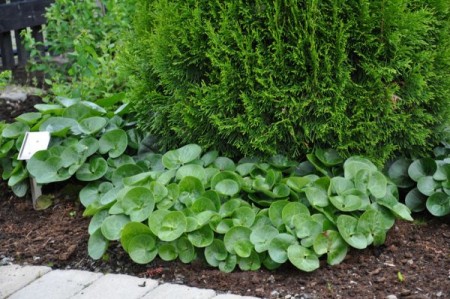
The hoofweed grows up to 10 cm in height, but in the garden it is always noticeable and immediately catches the eye.
It grows well and does not require much attention. Regular watering is enough for him. Even one plant is beautiful, and when the hoof grass completely covers an area of land, no lawn can compete with it. There is no desire to walk on such grass - it’s a pity.
Agricultural technology:
- Not picky about soil.
- Location: shady, damp places.
- Loves moisture, but also tolerates dry soil. A very unpretentious plant.
- Reproduction by seed and division of bushes. Such a ground cover can be dug up in the forest.
It turns out that this herb can quietly cure a person of alcoholism:
Periwinkle
A groundcover perennial with creeping shoots and overwintering leaves, beloved by many gardeners.
After a favorable snowy winter, a neat dark green periwinkle mat is decorated with heavenly colored chiseled flowers. It is unpretentious to growing conditions, but prefers to grow in partial shade in moderately moist loamy areas.
Periwinkle often used for turfing tree trunks, edging flower beds, and planted in borders and rockeries. It is quite easy to keep periwinkle within strictly designated boundaries: shoots that stray outside the flower beds or tree trunk circles are simply cut off with a shovel.
Agricultural technology:
- Not picky about soil.
- Prefers to grow in shade or partial shade, but can also grow in full sun.
- Drought-resistant, rare watering in hot summers.
- Responds well to the application of nitrogen fertilizer (once in the spring).
- Easily propagated by dividing bushes and shoots.
- It is a winter-hardy perennial, but in snowless winters the leaves may die, but the plant quickly recovers.
Periwinkle: planting, care, reproduction:
Creeping tenacious
This is a tenacious and creeping rhizomatous groundcover perennial with dark green leaves, blue candle inflorescences and creeping, easily rooted shoots.
It will grow everywhere, quickly covering and decorating open areas of soil, turning them into a dense carpet. It can even live on slopes. There is a survivor with white and pink flowers. The most beautiful plants are obtained when grown in shade or partial shade.
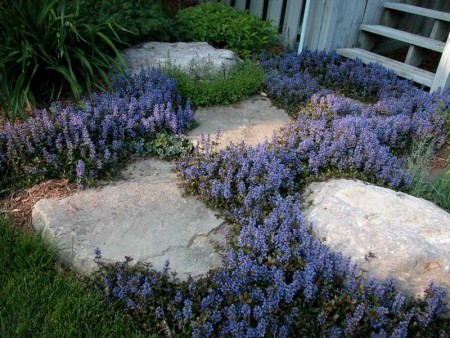
Tenacious is a surprisingly unpretentious and extremely tenacious ground cover, which also grows quickly.
Red tenacious (another variety of the plant) is valued for its purple leaves. The variegated tenacious leaf blades have creamy-yellow inclusions.
Brief agricultural technology:
- Sowing seeds directly into the ground, in a permanent place. It is better to buy seeds in a store; those collected independently do not retain their parental qualities.
- Location: shade or partial shade. The survivor will grow in the sun, but the leaves and flowers will be pale.
- The soils are loamy.
- Drought-resistant, abundant watering only after planting.
- Reproduction by dividing bushes and rosettes.
- Winter-hardy ground cover. Shelter for the winter is not required.
The opinion of flower growers about the creeping tenacious:
Ground covers blooming all summer
Sedum
This group includes more than 500 species of various ground cover plants. You can create a beautiful flower garden from sedums alone. Not only flowers, but also leaves with a wide variety of colors have decorative value.
Sedums are used not only as carpet compositions, but also for planting in rockeries, robotic gardens, and as border plants. They look beautiful on rocky slopes.
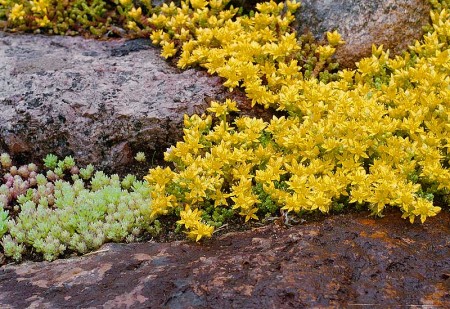
Sedum plants are unpretentious, but at the same time beautiful. Gardeners love them for this combination.
Most species prefer to grow in the sun, but there are some that feel better in the shade. Flowering begins in early summer and continues until autumn
Caring for this ground cover is minimal and can be done by the laziest summer residents. Almost all sedums are drought-resistant; they need to be watered only in hot summers.
Agricultural technology:
- It is not picky about soils; it can grow anywhere, both on sandy and rocky soils.
- Prefers a sunny location.
- Drought-resistant, water only during drought.
- Does not tolerate waterlogged places.
- Propagated by dividing the bush, digging in shoots. You can also propagate by seeds, but this is more difficult.
- Most sedums overwinter without shelter. Only rare, elite varieties need to be covered for the winter.
What are the types of video sedums:
Purslane
Although purslane is a perennial plant, it cannot survive our winters. However, thanks to its abundant self-seeding, it is enough to plant it once. In subsequent years, you will admire a beautiful, colorful mat that blooms all summer long.
If you are looking for ground cover flowers for lazy gardeners, then purslane is the best thing to recommend. It is difficult to find a cultivated plant that is as unpretentious and tenacious as this flower.
By and large, it is enough to sow the seeds and water them once or twice. In the future, this ground cover will grow and expand without your participation. These flowers don’t need to be watered at all - they have enough precipitation, you don’t need to loosen the soil - they even grow on paths, you don’t need to feed them - they don’t tolerate manured and peaty soil, and they also deal with weeds themselves.
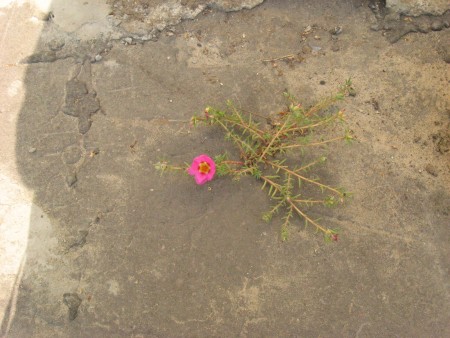
I took this photo on the platform of the railway station, on the south side. A small crack in the asphalt and purslane grows from it.
Agricultural technology:
- Growing by sowing seeds in the ground and through seedlings. When growing seedlings, soil from the store is not suitable. Take only ordinary soil and mix it with sand 3 to 1. Sowing seeds for seedlings in April.
- Location: sunny, but also grows in partial shade.
- Amazingly drought-resistant and can grow without watering.
- Does not tolerate low, damp places.
- Does not require loosening, weeding or fertilizing.
Purslane - holiday flower video:
We can recommend other plants for creating flowering garden mats.
Names of ground cover perennials:
- Horny goat weed.
- Strawberries.
- Garden geranium.
- Bryozoan.
- Rejuvenated.
- Garden forget-me-not.
- Fragrant violet.
Most groundcover perennials do not require constant attention. And yet, when planning to plant them, you should prepare the soil thoroughly: add humus or compost, dig, carefully selecting weed rhizomes.
The latter is very important: wheatgrass and bindweed will prevent ground covers from growing, and it is difficult to control weeds in a planted area.
Mature periwinkle, thyme, duchesnea, tenacious, etc. will already be able to compete with weeds and will not allow them into their territory, but in the initial period they need our help. This is common to all plants. Otherwise, for each species, both the planting site and agricultural technology are chosen individually.
By playing a “supporting role” in the garden, ground cover plants help the “soloists” look especially impressive, and at certain moments they themselves can play the “first violin”.
Continuation of the topic:
- Planting and growing aubrieta
- How to grow and where to plant alyssum
- Gaura - bush of fluttering moths
- Planting and caring for aquilegia in the garden
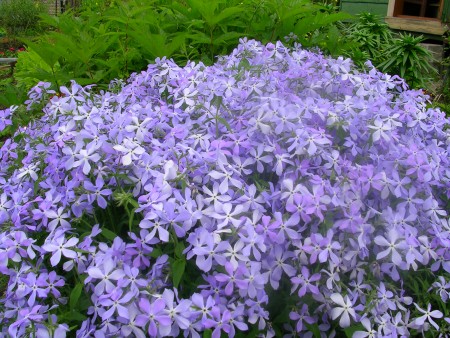

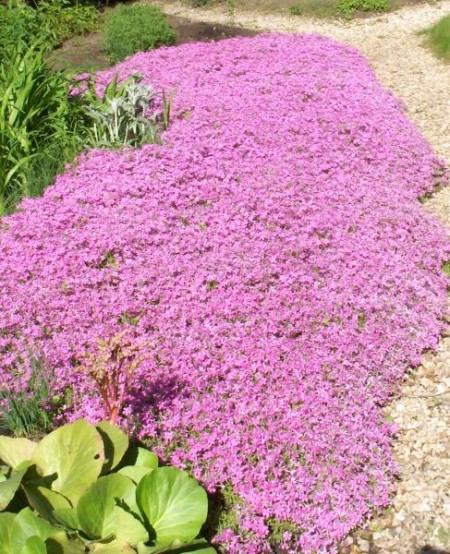
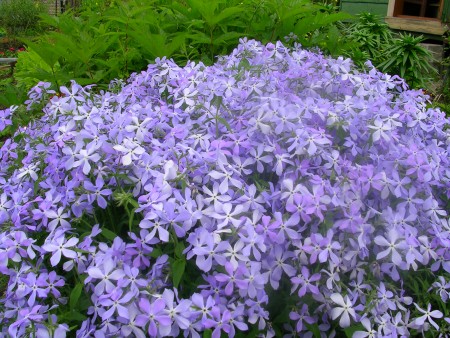
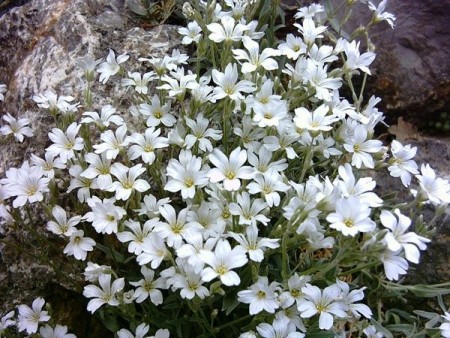
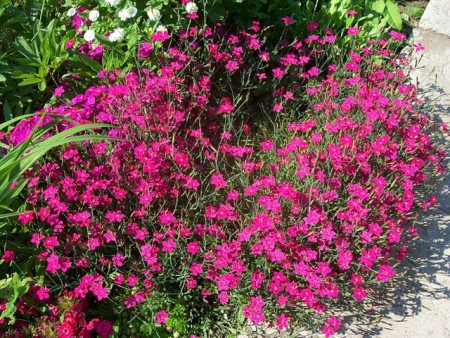
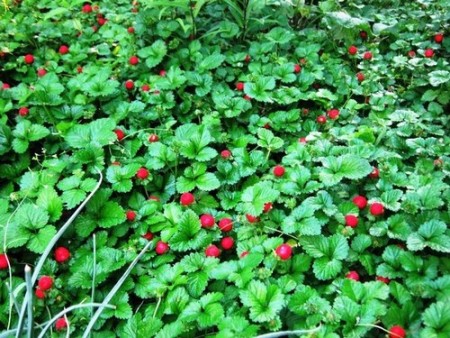
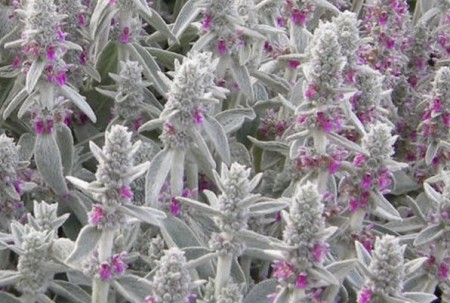
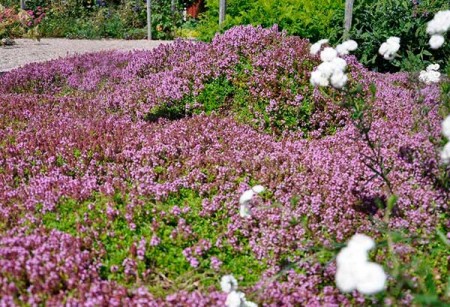
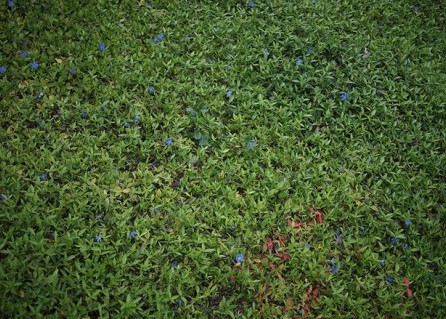
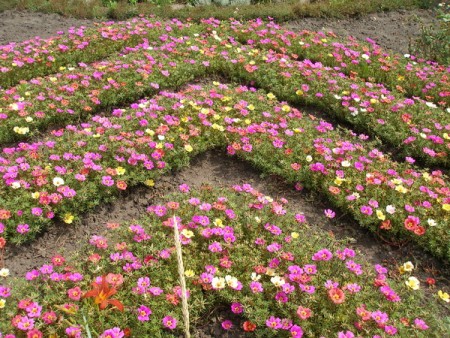

 (26 ratings, average: 4,27 out of 5)
(26 ratings, average: 4,27 out of 5) CUCUMBERS NEVER GET SICK, I'VE BEEN USING ONLY THIS FOR 40 YEARS! I SHARE A SECRET WITH YOU, CUCUMBERS ARE LIKE THE PICTURE!
CUCUMBERS NEVER GET SICK, I'VE BEEN USING ONLY THIS FOR 40 YEARS! I SHARE A SECRET WITH YOU, CUCUMBERS ARE LIKE THE PICTURE! You can dig a bucket of potatoes from each bush. Do you think these are fairy tales? Watch the video
You can dig a bucket of potatoes from each bush. Do you think these are fairy tales? Watch the video
 How our fellow gardeners work in Korea. There is a lot to learn and just fun to watch.
How our fellow gardeners work in Korea. There is a lot to learn and just fun to watch. Eye trainer. The author claims that with daily viewing, vision is restored.They don't charge money for views.
Eye trainer. The author claims that with daily viewing, vision is restored.They don't charge money for views. A 3-ingredient cake recipe in 30 minutes is better than Napoleon. Simple and very tasty.
A 3-ingredient cake recipe in 30 minutes is better than Napoleon. Simple and very tasty. Therapeutic exercises for cervical osteochondrosis. A complete set of exercises.
Therapeutic exercises for cervical osteochondrosis. A complete set of exercises. Which indoor plants match your zodiac sign?
Which indoor plants match your zodiac sign? What about them? Excursion to German dachas.
What about them? Excursion to German dachas.
Another excellent ground cover is lobularia (lawn grass). It is unpretentious to the conditions, the flowers are small - white, lilac or pink, depending on the variety. When flowering, they exude an indescribable aroma of honey)
Thanks for the addition, Alexandra.
Alexandra, lobularia is an annual. And the article is about perennials. This is a very interesting plant for borders though.